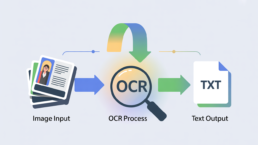The Future of Content Moderation: Trends for 2026 and Beyond
The evolution of content moderation in the last decade is both dazzling and overwhelming, powered by the latest in image recognition technology and AI developments.
Even considering only the last five years, we have witnessed a massive move towards automated content moderation that manages to keep up with the immense growth and diversity of new content.
The numbers speak clearly too. The content moderation services market size was valued at $12.48 billion in 2025, with projected growth to $13.94 billion in 2026, and to $42.36 billion in 2035. This illustrates the dynamics towards embedding content moderation in full power — across all types of platforms and websites with user generated content.
While growth is exponential, the challenges for effective content moderation are plenty too. Deepfakes and synthetic content remain a tough nut to crack. Multimodal moderation of image, video, and sound is another big topic, along with a real-time, proactive approach. Meeting legal requirements and ensuring ethical standards and bias mitigation are additional drivers of innovation in the field.
Keeping in mind both opportunities and challenges, what lies ahead for content moderation in 2026 and beyond? Here are seven trends that we at Imagga believe will be fueling the developments in content moderation in the coming years.
Real-Time Moderation Is Become the Norm
AI-powered tools have enabled real-time moderation and it seems there’s no way back.
Instant text, image, video and audio analysis is now considered standard, even for live video streaming. In fact, it has become a necessity in a digital environment oversaturated with user generated content. It allows platforms — from social media and community forums to gaming and e-commerce — to flag and block potentially harmful content that would otherwise spread in an uncontrolled way.
The focus in the coming years would be on improving the accuracy and contextual understanding of real-time moderation. Speed and precision have to be in balance, as false positives and false negatives have a direct negative impact on user trust. The other big task on the horizon is ensuring efficient, scalable and cost-friendly solutions for real-time analysis.
Multimodal Moderation On the Rise
In 2025, effective content moderation encompasses much more than analyzing a single image or text.
The rise of multimodal moderation spanning text, image, video, and audio analysis is pervasive and transforms the way platforms find and deal with inappropriate and harmful content. As users create and share more and more complex multimedia posts, this wholesome approach is currently the only one that can ensure optimal understanding of context and nuances.
The cross-referencing of visual data with speech, text and metadata allows the identifying of context and subtext — such as sarcasm, violent content, or cultural references. This approach can be applied in detecting multimodal disinformation campaigns, moderating multiple content streams simultaneously (such as video games and social media messengers), and much more.
A good example of content that requires multimodal moderation is the famous meme. It requires text-in-image moderation to handle the analysis of text embedded within images — which may completely change the meaning and purpose of the content.
The Power of Advanced Video Moderation In Action
Video content has been on the rise in the last years — and its moderation presents a complex challenge for platforms. It combines images, audio, and motion, which have to be analyzed coherently — and in real time.
Effective video moderation relies on the combination of frame-by-frame image analysis, speech-to-text conversion, and pattern identification. A cue for the moderation system can come from an inappropriate item detected in the visuals, in the speech contained in the audio, or even in the way the video is edited.
Real-time video moderation is and will continue to be essential for social media platforms, and especially for protecting users from potentially harmful live streaming video content. If problematic content is identified, the live stream can be stopped, or inappropriate videos can be immediately blurred.
In the years ahead, advanced video moderation will keep evolving to meet challenges like deepfake video detection and complex cultural contexts, as well as novel trends in harmful content.
The Hybrid Moderation Model Evolves
The complexity of online content grows by the day, and effective moderation requires advanced solutions. But could it be only human or only automated moderation?
The key to successful moderation lies in the hybrid approach. AI paired with human collaboration is, at this stage, the working model that provides the right balance between protection and freedom of expression.
The task of AI in this mix is clear — it is the firewall that provides the basic line of protection from inappropriate, harmful or explicit content. As its capabilities are evolving, it can also provide proactive and predictive moderation with transparent explanation that goes through human review.
The role of people in this hybrid combination has changed. Instead of having to sift through endless amounts of harmful content, moderators today take on the roles of AI trainers and reviewers. Their task is to guide the training of the AI models, to define ethical standards, and to review specific cases for context, nuances, social norms, fairness, and precision.
Handling New AI Content Challenges
Generative AI has become pervasive, and digital platforms need effective ways to handle its potential negative impact. Deepfakes, synthetic content, and AI visuals have become hyperrealistic and are already difficult to distinguish from authentic ones, but keeping a safe digital environment makes this differentiation paramount.
Advanced image recognition models are continuously being updated and trained to meet these evolving challenges. They can spot digital artifacts, altered pixels, texture inconsistencies, and unnatural movements that may be contained in synthetic and fake content.
Content provenance frameworks like the Coalition for Content Provenance and Authenticity, or C2PA, and blockchain verification systems are often included in the mix. They allow moderators to track the origin and modification history of visuals.
Legal Requirements Push Innovation
The global regulatory framework is becoming a major factor in content moderation innovation. National and international bodies are updating and upgrading their legal acts to reflect new threats and technologies. The results are often more stringent rules that digital platforms have to integrate to stay compliant.
The most recent legislation that affects moderation and AI technologies includes the EU’s Digital Services Act (DSA), fully enforced in February 2024, the EU’s AI Act, which is gradually being enforced too, the UK Online Safety Bill enforced at the end of 2023, and the US TAKE IT DOWN Act that was passed in 2025.
While the new regulations are obligatory, they are also driving innovation. Forward-looking digital platforms use its framework to create transparent and accountable moderation systems. Crucial points they integrate include data provenance, balance between safety and censorship, and ethics and bias measures. In this way, legal requirements become a source of brand trustworthiness, supporting user trust and brand integrity.
Ethical Approach and Bias Mitigation Are Required
With the growing role of AI in moderation, mitigating bias and ensuring a high standard of ethics become paramount to guaranteeing trust and compliance. Digital platforms thus now have to provide effective content moderation that also takes into account cultural diversity and avoids any form of discrimination.
Leading content moderation systems thus employ ethical-by-design frameworks that are trained on diversified data, run frequent bias audits, and have human review requirements. This approach guarantees the omission of unbalanced or biased datasets, as well as the minimization of misinterpreting cultural and social cues.
The path forward is towards developing and sustaining context-aware moderation. Content moderation systems will keep gaining understanding of cultural, artistic, and historical value and meaning, so that their analysis goes beyond the literal and into the metaphorical and abstract. This cultural intelligence is becoming the norm for moderation services in 2026 and beyond.
Get Started with Content Moderation Innovation
Imagga has been pushing the boundaries of image recognition for more than a decade. We’ve developed a complete portfolio of content moderation tools that help businesses stay abreast of both regulatory requirements and industry trends.
From smart video moderation to adult content detection, Imagga offers robust tools for keeping your digital platforms safe, compliant and user-friendly.
Get in touch to start your content moderation strategy with a trustworthy partner.
This publication was created with the financial support of the European Union – NextGenerationEU. All responsibility for the document’s content rests with Imagga Technologies OOD. Under no circumstances can it be assumed that this document reflects the official opinion of the European Union and the Bulgarian Ministry of Innovation and Growth.
The Content Moderation Glossary
When you open an online platform, whether it’s social media or an ecommerce website, it doesn’t take long to notice that things can get messy. That’s the raison d'être of content moderation — the behind-the-scenes mechanism for keeping platforms safe and user-friendly. In this content moderation glossary, we've compiled all important definitions you need to know.
In a nutshell, content moderation is a complex and elaborate process of monitoring and filtering content on digital platforms. Its goals are to protect users, uphold community guidelines, and respect legal requirements.
With the exponential growth of user-generated content (UGC), the necessity for content moderation has become paramount — and digital platforms are experiencing this first-hand. Due to the sheer amounts of content being published constantly, automated content moderation is now the most effective and scalable mode that is being used across industries.
But what exactly is content moderation and what terms do you need to know to understand both the big picture and the nitty-gritty details?
We know the lingo can get confusing, so here is our handy content moderation glossary. It contains the key terms that will help you grasp the particularities of the moderation process and to apply it effectively in your digital business.
The Basics About Content Moderation
The moderation process involves the screening and assessment of the suitability and safety of online content.
Before automated AI moderation, it was up to human moderators to sift through the massive amounts of content. This required rigorous work of flagging posts and visuals and making decisions on the go. But with time, the amount of posts became unmanageably large, and the content — more and more complicated.
Today we’re counting on technology to do the heavy lifting, while manual moderation is only necessary for setting moderation thresholds, clarifying cultural nuances, and settling delicate cases. The rise and fast development of machine learning algorithms and Natural Language Processing (NLP) allows automated moderation to make big jumps fueled by AI.
Types of Content for Moderation
Content moderation is still complex, though, despite the huge effect of using AI in the moderation mix.
There are different types of content to monitor, and each type requires different technology and approaches:
- Text moderation is the most common form. It entails the screening of posts, comments, and chats to prevent the spread of harassment, hate speech, offensive language, and spam. While it’s the most developed moderation type, nuances in language and expression still pose a challenge, so human review may be necessary in some cases.
- Image moderation is, to a large extent, automated, thanks to the developments in image recognition technology. It can screen for harmful, violent, and Not Safe for Work visuals. Since images can have a much stronger effect on users, image moderation is especially important for ensuring safe online environments.
- Audio moderation often entails speech-to-text transcription, so that the moderation models can analyze the text for offensive and harmful language. It’s being used for live chats, podcasts, and other audio formats online.
- Text-in-image moderation targets harmful and prohibited messages within images, such as memes, screenshots, and captured photos. It is deployed through a combination of optical character recognition (OCR) and text moderation tools.
- Video moderation requires the most complex mix of technology and approaches since it contains a large number of images, as well as audio and text. We’ll look into it in detail in the next section.
Varieties of Moderation Approaches
Besides the different types of content that need moderation, there are a number of approaches to the monitoring process. They include:
- Pre-moderation is a proactive approach in which all content is reviewed before publishing. While it ensures full protection for online communities, it is quite slow for the current digital landscape.
- Post-moderation is a reactive approach. The content gets published, and afterwards harmful or disturbing content gets reported or flagged and then removed. It enables real-time interactions, which is great, but brings the risk of exposure to harmful content.
- Reactive moderation is, obviously, a reactive approach in which unsuitable content is reported by users. It relies on the responsibility of community members, but may lead to the easier distribution of harmful content.
- Manual moderation entails the human review of content. Today this is mostly used for content that has been flagged by AI monitoring. Human moderators decide on complicated and sensitive cases where nuances and context are needed.
- Automated moderation is powered by machine learning models that can review and flag content in large amounts and at great speed. It is fast and effective, but still needs some support from human moderators in handling cultural nuances and context.
Video Moderation: Technology on the Rise
Moderating text is certainly not an easy feat — especially when you consider the large spectrum of nuances, cultural and social context, language diversity, and slang.
But video moderation is yet another beast. Each frame within a video, as well as the complementary audio and potentially even text, all have to be screened and analyzed for harmful content. The task becomes unimaginably difficult when you think about the massive amounts of short-form video that needs to be screened on social media.

The volume and complexity of video moderation have practically made it an impossible job for human moderators. AI-powered moderation platforms, however, can have a central role in this process. They can provide a high level of accuracy, immense scalability, and speed. While human input may still be needed at times to clarify borderline or complex cases, the hard work can go through the automated platform.
With the power of image recognition and machine-learning algorithms, moderation tools can detect problematic content like nudity and violence in real time. They can be instrumental in spotting deepfakes, as well as harmful content in text within the video. Live video streams can also be monitored in this way, providing a method for user safety even in this challenging setting.
In our hectic digital environment, smart video moderation can be a crucial factor that promotes brand reputation and platform trust. This makes it a win-win method for both businesses and users.
The Content Moderation Glossary
After getting to know the basics about content moderation, you’re ready to dive into the glossary.
Here is the compilation of terms that we believe are the most relevant ones to the process and specificities of content moderation today.
Adult Video Content Detection
The moderation process of identifying explicit or Not Safe for Work (NSFW) video content is referred to as adult video content detection. It typically involves distinguishing between explicit, suggestive, and safe content with certain pre-set thresholds.
API
The abbreviation API stands for Application Programming Interface. It enables communication between different software applications. APIs are used for web apps, mobile apps, and software libraries.
Automated Moderation
Automated moderation is possible due to the developments in AI algorithms. Moderation systems can monitor all types of content, at scale and with great speed.
AI Regulation
National and international bodies, as well as different organizations, create rules and guidelines for using Artificial Intelligence in various aspects of our life and work. They aim to ensure the safety and transparency of AI systems.
AI-Powered Moderation
Machine learning algorithms are being used to boost the moderation process by quickly identifying harmful and illegal content in text, images, videos, and even live streaming.
Brand Reputation
The reputation of a brand refers to the public’s perception of that company or platform. Content moderation helps protect a brand’s reputation by ensuring a safe digital environment for its users that also adheres to legal requirements.
Community Guidelines
This term refers to a set of rules that a digital platform creates to ensure safety and appropriateness. The guidelines define the activities that users can engage in or should refrain from.
Computer Vision
Computer vision is a broader technology term that includes image recognition. This technology allows computers to ‘perceive’ visual data and understand its content and meaning.
Content Policy
Digital platforms create content policies in order to guide their content moderation efforts. The policy contains the principles and thresholds for content monitoring.
Copyright Issues
In the context of content moderation, copyright issues refer to cases when users upload content whose copyright has not been cleared with the owners or authors. This may include texts, images, videos, and the like.
Deepfakes
Images, videos, or audios that imitate real people but are used in a deceitful or manipulative way are referred to as deepfakes. Their uncontrolled distribution is a serious concern for digital platforms.
Explicit Content
This term may include various types of content that is sexual, violent, or inappropriate in some other way. It is closely related to Not Safe for Work (NSFW) content.
Explicit Content Detection Models
These AI models are trained to identify, flag and remove adult content, including nudity and sexual images. They can be applied for both images and videos.
Flagging, Review and/or Removal
These three terms relate to the content moderation process. When content is being screened, it may get flagged by the automated moderation system because of potential issues. Then it may be reviewed additionally by human moderations. In case the issues are substantial, the content may then be removed.
Fraud Detection
AI systems can be used to provide an additional level of security for digital platforms through fraud detection. This involves the monitoring of fake accounts, disturbing behaviour, scam, and the like.
Generative AI
AI tools that can create new content, such as text, audio, images, and video, are called generative. They have been trained through deep learning on large datasets and aim to reproduce human creative output.
Harmful Content
Harmful content can take different forms, including text, images, audio, video, and live stream. It can be categorized as such due to potential emotional and psychological harm.
Human and Hybrid Moderation
Human moderation is the process of manual content review executed by people. The hybrid mode is a mixture between automated moderation and human review that ensures that high speed is matched with great accuracy.
Image Moderation
The moderation of images refers to the process of screening visual content for harmful and illegal elements. Today it’s handled to a large extent through automated moderation, powered by computer vision and machine learning algorithms that can ‘see’ and make decisions on the level of safety of the content.
Image Recognition
Image recognition is the powerful technology that enables the moderation of visual information. It is based on AI algorithms that allow computers to perceive the objects in images, such as objects, people, and scenes, and assess their details.
Misinformation and Disinformation
When false information is shared by mistake, this is referred to as misinformation. In the case of purposeful spread of fake information, the term used is disinformation. It's the intention of the user that sets the two terms apart.
Moderation Filters
Moderation filters contain custom-set rules or settings that guide the moderation process. The filters identify specific text or visuals, so that the problematic content does not get published or gets removed quickly.
Multi-Modal AI Models
With the rise of video online, AI models have to handle the moderation of various types of content at once. Multi-modal models can process text, audio, video, and images to provide robust and precise content monitoring.
Natural Language Processing (NLP)
NLP is a field of AI technology that enables computers to understand, interpret, and create human languages. This allows effective text moderation.
NSFW
The abbreviation refers to the term Not Safe For Work, sometimes also written Not Suitable For Work. It encompasses content that is explicit, violent, or otherwise inappropriate for viewing.
Live Streaming Moderation
Moderation of live streaming is a complex process that involves the monitoring of different content types simultaneously and in real time — including audio, video, images, and text. It is applied for screening of live streams, video games, live chats, and the like.
Pre-moderation
This is a proactive mode of moderation. Content is reviewed before it is published online. It ensures a greater level of protection, but is slower.
Post-moderation
Post-moderation is a reactive moderation mode. After being published, content may get flagged for review and removal. It allows real-time communication, but has a higher risk exposure.
Reactive Moderation
In this mode of moderation, content is removed only after a specific flagging from users. It is appropriate only for some types of online platforms since harmful content can be spread more easily.
Real-Time Moderation
The speed and massive amounts of content in today’s digital world often require real-time moderation. It refers to the process of instant detection and removal of harmful or illegal content. This is especially important for video and live streams.
Synthetic Content / Data
Computer generated data, usually for algorithm training purposes, is called synthetic. It can include text, images, audio, and video. Synthetic data can provide algorithms with a data alternative that respects privacy and overcomes data scarcity, but can raise bias and diversity issues.
Text Moderation
The process of monitoring and removing unsafe text content is called content moderation. It has been powered by the rise of Natural Language Processing (NLP).
Text-in-Images Moderation
This term refers to the moderation of harmful or misleading text that is embedded within visuals. This can include memes, screenshots, and other types of captured visual material.
Trust and Safety Programs
Trust and Safety programs aim to create a wholesome framework for user protection. Digital platforms formulate them in order to foster safe online environments, guarantee their users’ privacy and security, and uphold their brand reputation.
User-Generated Content
UGC, or user-generated content, entails all types of content created and/or posted directly by users on digital platforms. It can span text, images, audio, video, and live streamings.
Video Moderation
Identifying and removing video that contains harmful or explicit content is called video moderation. It’s an elaborate process that includes the review of images, audio, and even text. This type of moderation is one of the most complicated and resource-heavy.
Explore the Power of Automated Content Moderation for Your Digital Platform
Content moderation has become indispensable in the digital world of today — and it has become more effective and manageable with the power of AI. Applying cutting-edge moderation methods in the smartest ways is what can set your digital platform apart from the rest.
Get in touch to explore how Imagga’s content moderation solutions can be easily embedded in your workflow, ensuring maximum protection and efficacy for your digital platform.
This publication was created with the financial support of the European Union – NextGenerationEU. All responsibility for the document’s content rests with Imagga Technologies OOD. Under no circumstances can it be assumed that this document reflects the official opinion of the European Union and the Bulgarian Ministry of Innovation and Growth.
How OCR Powers Content Moderation for Text in Images
What is OCR in Content Moderation?
OCR (Optical Character Recognition) is applied in content moderation to identify and analyze text inside images, making sure that harmful or inappropriate content doesn’t circulate hidden in screenshots, memes, and other user-generated visuals.
Online conversations are not what they used to be — we don’t write so much, but rather share our thoughts, opinions and jokes through screenshots, memes, and other images.
While this image-based communication gives us a lot of creativity, it comes with its risks. Offensive or fake texts can sneak in such visuals and travel unhindered around in the digital space.
There’s a huge difference between moderating regular text and text within images. As traditional text analysis doesn’t work for the latter, this is where the crucial role of OCR for text-in-image moderation kicks in.
What’s the Difference Between Text Moderation and Text-in-Image Moderation?
Both text moderation and text-in-image moderation aim to spot inappropriate text content.
Text moderation is the traditional method through which digital platforms filter and analyze plain text. It may be coming from user posts, comments, chats, or the like. Text moderation is a straightforward process, as algorithms are already used to processing it in large quantities.
Text-in-image moderation, on the other hand, is more challenging. It is the moderation tool for handling text within images that uses OCR to extract text from visual content. Then it can be screened in the traditional way to check whether it meets moderation policies. It’s worth noting also that unlike classical image moderation, text-in-image moderation doesn’t focus on moderation of visuals.
To have a complete grasp of different moderation modes, it’s important to differentiate between types of content and embedding. Without text-in-image moderation, filters can be bypassed through text included in visuals — which can lead to the wide distribution of harmful or inappropriate content.
How Is OCR Used in Content Moderation?
Optical Character Recognition gives computers the skill to recognize text that is embedded within images. Here is how OCR naturally complements the text-in-images moderation process with a crucial tool.
The first step of this type of moderation is text extraction. OCR processes an image and turns text into data that can be read by machines. This is done with a high level of accuracy and is not impeded by the presence of colors, different fonts, or complex backgrounds.
Once the text has been ‘read’, it can be analyzed for harmful and inappropriate language, hate speech and other serious issues, such as harassment and bullying, self-harm and suicide content, spam, scam, fraudulent ads, and personal data and privacy leaks.
Think about harmless-looking memes on social media — which may easily contain repulsive, harmful or illegal text. Without OCR in action, it would slip unnoticed. The same goes for, say, counterfeit products with fake branding on ecommerce websites.
Advanced OCR solutions are applied together with Natural Language Processing (NLP) algorithms to help understand context, intent, and cultural nuances. On the basis of this textual and contextual analysis, the moderation system can take action on certain content, such as flagging for review and removal. OCR thus helps moderation platforms to bypass the blind spot of text embedded in images.
The Challenges of OCR in Moderation
Optical Character Recognition is a powerful tool that has immense benefits for content moderation. Yet there are some challenges that moderation platforms have to keep in mind.
Image Quality
Various factors of image quality can affect the precision of OCR ‘reading’, including low resolution, noisy backgrounds, and distorted fonts. For example, memes usually contain warped, bold, or shadowed letters that can be difficult to process. As OCR models advance, they have to be continuously trained on new data to recognize distortions and work with poor image quality.
Language Diversity
If only harmful text could be solely in English… But the reality is that content moderation has to work effectively in numerous languages, recognizing various alphabets, scripts, and even emojis and slang. State-of-the-art OCR solutions have to be multilingual, so they can handle Latin, Cyrillic, Arabic, and Asian languages, among others. They also need constant updating to stay current with the novelties of internet language.
Speed and Scale
With the sheer amount of user-generated content like memes and screenshots uploaded online daily, digital platforms have a lot of work in terms of text-in-image moderation. Automated content moderation can stay on top of these content volumes, and the same counts for OCR. It can handle massive amounts of content in real time.
Bypass Tricks
Word distortion, symbols, and text split on different images — these are just some of the evasion tactics that some users apply, so they can share harmful text-in-images content. OCR systems need constant updates and anti-evasion tools, so they can keep catching harmful content despite bypass tricks.
The Benefits of OCR for Moderation Teams
The advantages of embedding OCR in the content moderation process are not theoretical — they are tangible.
Moderation teams get concrete benefits that make their work easier and more effective:
Increased Detection Accuracy
Harmful or inappropriate text would go unnoticed without OCR — so its use automatically improves the precision of content moderation. All the memes, screenshots and other user-generated content that contains such text goes through additional screening.
Closed Gaps of Potential Exploitation
Including harmful text within visuals is a common evasion tactic used by bad actors. OCR doesn’t allow this inappropriate content to slip through. As social media struggle with memes and other images that go against their policies, OCR offers a viable solution for text-in-images moderation that significantly reduces the violations.
Enhanced Trust and Safety
People lose trust in a digital platform when they notice harmful content that spreads freely. That’s why effective content moderation that embeds OCR ensures digital spaces’ safety, which in turn also boosts user loyalty and brand reputation. This helps moderation teams hit their Trust and Safety program goals.
Improved Regulatory Compliance
Content moderation regulations such as the EU’s Digital Services Act (DSA) are getting stricter, and digital businesses have to adhere to them to stay on track and avoid penalties. Applying OCR in the content moderation workflow allows moderation teams to hit regulatory compliance goals, guaranteeing accurate moderation of text-in-images.
Imagga’s Text-in-Image Moderation
Imagga’s Text-in-Image Moderation is built on our advanced adult content detection model for images and short-form videos and is embedded within these solutions. By providing effective moderation of text embedded in visuals, it closes a significant gap in visual content safety tools, completing our powerful Imagga Moderation Suite.
Our system employs OCR together with a precisely calibrated Visual Large Language Model, combining exact character recognition with contextual insights. Extracted text is organized in a set of categories, including safe content, drug references, sexual material, hate speech, conflictual language, profanity, self-harm, and spam.
Besides text extraction at scale, our Text-in-Image Moderation is trained to understand context, nuance and metaphor. It operates in multiple languages and writing systems.
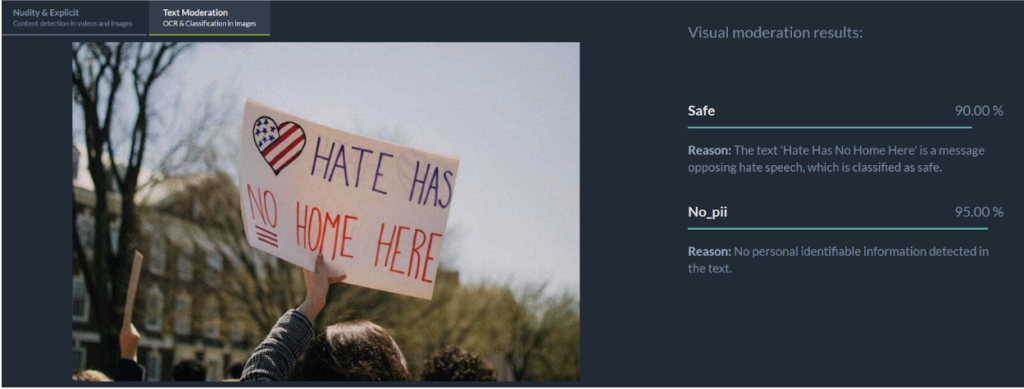
In addition, it provides PII detection, protecting users’ sensitive information. It spots any sharing of personal data such as names, usernames, contact details, financial data, and the like — whether it has been accidental or intentional.
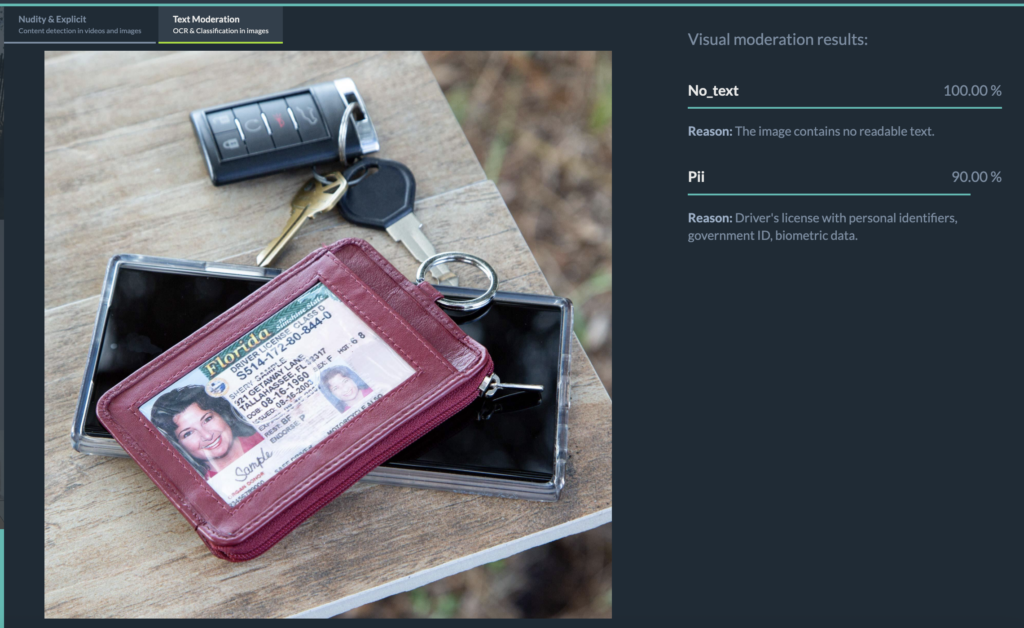
The Text-in-Image Moderation can be fine-tuned to meet the particular needs of digital businesses, such as customizing, including or excluding certain types of content in the moderation process.
Want to check out how it works? Take a look at Imagga’s Text-in-Image moderation in action in our demo.
Get Started with OCR for Effective Text-in-Image Moderation
Memes, screenshots, and all types of visual content are here to stay in our digital environment, so effective moderation of text in images is a must.
That’s why text-in-image moderation powered by OCR is not simply a nice perk. It’s a crucial tool for getting a hold of harmful or inappropriate text embedded within visuals that would otherwise slip through the cracks.
Effective text-in-image moderation is essential for digital businesses that want to thrive. It helps them safeguard their brand reputation, provide user safety, keep their regulatory compliance, and support long-lasting customer relations.
Imagga is a trusted partner in this process. Our AI-powered OCR technology helps businesses identify moderation issues in visual content — and deal with them in quick and smart ways.
Ready to get started? Get in touch with our AI experts today.
FAQ: OCR for Text in Images
What is OCR?
OCR stands for Optical Character Recognition. It’s a technology that empowers computers to recognize text embedded within visuals, such as words in memes, screenshots, and other user-generated visuals.
What is text-in-image moderation?
Text-in-image moderation is a type of content moderation that entails identifying and filtering harmful or inappropriate text hidden within images. These may include memes, screenshots, scanned documents, and even video frames.
What’s the difference between text moderation and text-in-image moderation?
Text moderation is the process of screening text content like posts, comments, and chats in order to ensure it’s safe and legal. Text-in-image moderation entails using OCR to ‘see’ text within images, so that it can be analyzed in the same way for safety and compliance.
Why is OCR important for content moderation?
Offensive language, misinformation, hate speech, and other types of inappropriate text can be easily hidden within user-generated visuals. Traditional text moderation doesn’t catch it. That’s why OCR is crucial for text-in-image moderation.
What types of content can OCR tackle?
OCR can extract text from different types of visuals, including memes, screenshots, scanned documents, and even video frames.
This publication was created with the financial support of the European Union – NextGenerationEU. All responsibility for the document’s content rests with Imagga Technologies OOD. Under no circumstances can it be assumed that this document reflects the official opinion of the European Union and the Bulgarian Ministry of Innovation and Growth.
Visual Search in E-commerce: The Smartest Way to Turn Browsers into Buyers
Gone are the days when text-based queries were the standard way to search for products online. Visual search in e-commerce is already prevalent, and it has revolutionized how customers find items they want to purchase.
Visual search engines enable users to upload an image of a product they like, allowing them to discover relevant items or additional information. As this method of product discovery is much easier than trying to describe a product with words, visual search has gained immense momentum. It is already the preferred way of searching online for younger consumers, and certainly for both Millennials and Gen Z.

With the exponential growth of visual search popularity, many search engines have integrated these capabilities, followed by a wide range of other digital businesses. In 2024, the global visual search market size was valued at $41.72 billion and is expected to reach $151.60 billion by 2032.
The technology holds immense potential for boosting the bottom line of ecommerce businesses. Consumers use it regularly when looking to buy clothes, furniture, cars, groceries, holiday trips, electronics, and household items, among others. They prefer visual search because it offers improved experience and easier product discovery, which naturally translates into higher conversion rates for companies.
So how can you integrate visual search in your ecommerce platform and maximize its benefits for your business?
In the guide below, we have outlined the most important strategies and tools that you need to enhance your ecommerce success with visual search capabilities.
Visual Search Technology
Visual search engines integrated in search platforms, such as Google Images, are able to provide adequate search results by using image metadata. There are also reverse image search engines like TinEye, which enable people to look for similar images or find the source of an image they have.
The practical applications of visual search are diverse. It can be used to identify many different types of products like clothing and home decor, as well as plants, animals, and other objects.

As the visual search results yield relevant images, data and context, they help customers find what they’re looking for with ease. Besides locating a desired item online, visual search can also provide additional tools like same object recognition, which allows the identifying of an object in different images.
Visual Search Examples
Many applications and platforms have already integrated visual search to provide users with an innovative and easy way to look for products and information.
Google Lens
Google has developed the popular visual search tool Google Lens. When users upload a visual, they can get information and similar products, as well as identification of objects within the image.
People can also just point their phone camera at an item to get reviews about the product, as well as purchase options. Obviously, this is a great tool for ecommerce, but also has numerous applications in tourism, plant and animal identification, and translation from foreign languages.
Pinterest Lens
The Pinterest Lens is another example of a visual search tool integrated into a platform. It allows users to find similar products and creative ideas. The particular focus of Pinterest Lens is helping people explore fashion trends, clothing and jewelry, furniture and home decor, makeup, and more. Visual suggestions like those provided by Pinterest Lens are quite handy in finding relevant ideas and inspiration.
Bing Visual Search
Microsoft has developed Bing Visual Search and has integrated it in its search engine. It functions similarly to Google Lens, allowing people to upload an image instead of writing a text search query.
The Benefits of Visual Search in E-commerce
The benefits of visual search in e-commerce are numerous — and online shoppers across the globe are already benefiting from them to find products and information about items, while businesses see increases in conversion rates and revenue.
Improved Customer Experience
People don’t need to come up with lengthy descriptions of a product that the traditional text-based search requires. Instead, they can just take a snapshot of the desired item and upload it in the search.
Visual search transcends language barrier issues when shopping abroad or from foreign platforms. It also enhances mobile shopping experiences with immediate access to image queries.

In the long run, this makes customers more engaged with a shopping platform — and more likely to return to it. And let's not forget that visual search adoption is on the rise globally.
Easier Product Discovery
Users can find the exact item they are looking for with visual search results — whether it’s a snapshot they take in real time, an ad, or a social media post. They also get visual suggestions for relevant and complementing products. This is beneficial for customers, but is also a great opportunity for businesses to increase their product discoverability.

Increased Conversions and Revenue
When people find the products they're looking for with ease, they are more likely to make purchases. With visual queries they can get an exact match of their search, as well as more context and relevant information. Consumers can thus order the right products that they want, which reduces returns and shipping expenses.
Business Advantage
For businesses in particular, integrating visual search also brings a clear competitive advantage. By offering an innovative search experience, your ecommerce business can stay ahead of the competition and cater to customers’ evolving needs.
Implementing Visual Search in Your Ecommerce Platform
Providing visual search to your customers straight in your platform is definitely a winning move. Features like image upload and search enhance the search experience — driving both user engagement and sales.
To offer visual search, you have to integrate visual search capabilities in your ecommerce website or app. Creating your own visual search engine is quite a feat and is usually the path that large companies take since it requires substantial teams, time, and resources.
Luckily, tools like Imagga’s visual search API are there to offer a powerful and easy solution for ecommerce businesses of all sizes. Integrating the API in your platform is a straightforward process with detailed documentation and guidance.
Imagga’s Visual Search API boasts high accuracy rates and has a scalable infrastructure, which means it can handle large amounts of requests and search pools with precision. In addition, our expert team can customize the tool for your particular needs.
Visual Search and Social Media
The intersection of visual search and social media is definitely a field worth exploring. As social media platforms are constantly expanding their image search options, the opportunities for e-commerce expansion they’re offering are growing. This is especially important given the fact that people increasingly use their phones for online shopping, and visual search is especially user-friendly on mobile devices.
In particular, social media shopping features hold great potential for ecommerce. Many users find products they like on social media. Having the option to directly make a purchase from a post or an ad within the platform is thus an easy way to increase conversions. A number of social media giants have already created such features, including Facebook, Instagram and TikTok, and you can integrate them with your ecommerce platform.
Another way to leverage social media for your ecommerce is optimizing your content for visual search on platforms like Pinterest and Instagram. This will allow the visual search tools to find and index your content, increasing the chances of your products being discovered by customers. Don’t forget to include relevant keywords and hashtags too.
Last but not least, keep in mind that brand consistency on your website and social media channels is important. Using coherent images and text across platforms creates a sense of uniformity, which strengthens your brand identity in the eyes of customers.
The Future of Visual Search Technology
Visual search has already changed our interactions with the digital and physical world. As its popularity and capabilities grow, it is likely to become the norm in online product searching.
Technological advancements — particularly in AI and machine learning — are poised to make visual search better, faster, and more integrated in our digital experiences.
Augmented reality (AR), in particular, holds great potential for complementing and improving visual search. It can provide interactive experiences like virtual try-on for products and instant information about items.
Visual search technology keeps evolving and surprising both businesses and consumers. From smart devices to the Internet of Things, the technological novelties that are yet to come will offer unexpected new tools for ecommerce success and for engaging customer experiences.
Boost Your Ecommerce Platform with the Power of Visual Search
Imagga boasts cutting-edge visual search technology that you can embed straight into your ecommerce platform. Our AI-powered visual search tools allow you to offer seamless image search and visual recommendations to your customers with high accuracy and scalability.
Get in touch to learn more about integrating visual search in your ecommerce with our cloud image recognition API or on-premise solution.
Imagga’s Adult Video Content Detection Model: Smarter Moderation, Safer Platforms
Video is everywhere today — from social feeds and online communities to shopping sites and e-learning platforms. It’s engaging, relatable, and immediate. But this very immediacy makes video moderation critical. Inappropriate or explicit content can spread fast, harming users, brands, and trust. That’s why Imagga’s Adult Video Content Detection Model is designed to tackle this challenge head-on. Our AI-powered system brings accuracy, and scalability to video moderation, ensuring that platforms stay safe, compliant, and user-friendly.
Why Video Adult Content Detection Is Hard
Adult video content detection is challenging because of the sheer volume, complexity, and speed at which videos are shared. Traditional moderation methods can’t keep up with thousands of uploads each day, nor with the expectation for real-time review to stop explicit content before it spreads. While human moderators still play a role, it’s nearly impossible for them to consistently catch subtle or borderline NSFW material, and they may struggle with cultural nuances and context. AI-powered moderation addresses these issues by processing large volumes quickly, distinguishing between explicit, suggestive, and safe content with clear thresholds, and allowing for customization to match different cultural standards. Most importantly, advanced models help reduce mistakes, minimizing false positives and missed explicit clips, protecting both user trust and platform reputation.
How Imagga's Advanced Model Enables Effective Video Moderation
To overcome these challenges, new technology offers impressive solutions that can handle the volume, speed, real-time demand, and complexity of video distribution today.
Using cutting-edge AI technology based on image recognition and machine learning algorithms, Imagga's Adult Content Detection Model provides highly accurate video analysis. It performs reliable and scalable adult detection in real-time — outperforming other adult content detection models by up to 26%. On top of that, we can customize the model to the particular needs of a specific business.
The power of Imagga’s video adult content detection model lies in its precise classification, context-rich tagging, and frame-by-frame analysis.
Best-in-Class Precision and Recall
With precision now at 0.96 and recall at 0.98, our upgraded model detects explicit and suggestive content more accurately than ever. This means fewer false positives, fewer misses, and more trust in your automated video moderation — even as your content volume grows.
Smarter, Faster Video Analysis
Our optimized scene analysis method significantly speeds up processing by reducing the number of frames analyzed, without compromising accuracy. This makes the analysis more cost efficient, while still detecting even subtle or hidden adult content (as few as 1–3 frames). Built on a high-quality dataset and a custom AI pipeline, our model ensures you get efficient, reliable moderation at scale.
Precise Scene-Level Classification
The model breaks videos down into clearly defined scenes. Each scene is individually analyzed and classified as explicit, suggestive, or safe, accompanied by exact timestamps. This allows moderation teams to pinpoint problematic sections immediately, dramatically improving workflow efficiency.
Context-Rich Tagging for Deeper Insights
Beyond scene classification, Imagga provides contextual tags that offer deep insight into why content is flagged as suggestive or explicit. This is achieved by using additional AI models on top of Imagga’s world-class classification system. The tags highlight specific visual elements commonly associated with adult or borderline content, such as "swimsuit," "belly exposed," or "armpits exposed". Each accompanied by a confidence score indicating the likelihood of their presence. These granular, context-rich tags give moderation teams the clarity they need to make faster, more consistent, and more accurate decisions.
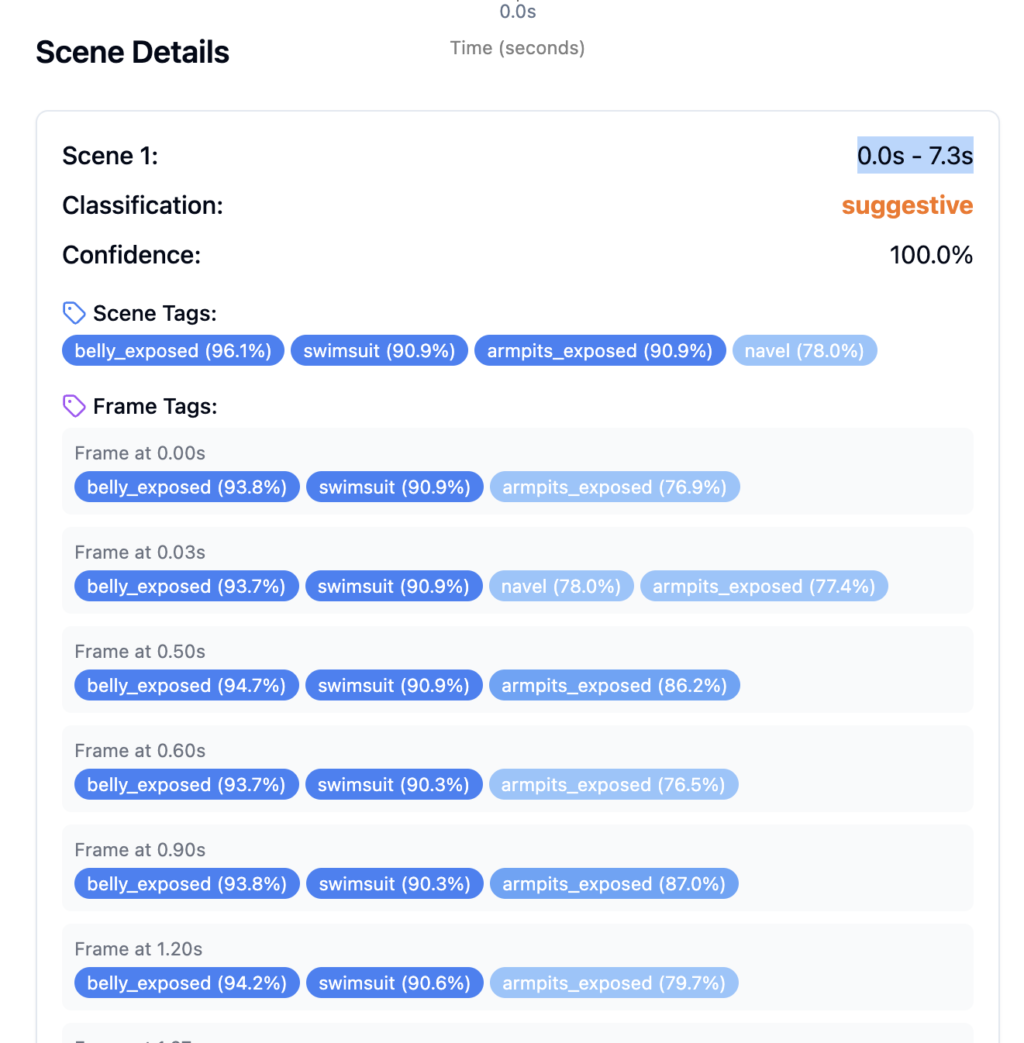
Practical Applications
Adult content detection is essential for a wide range of digital platforms that require a high level of safety and compliance measures.
Most types of user-generated content platforms fall in this category, and in particular, social media platforms. The spread of explicit video materials can easily go out of control. Video moderation allows social media channels to uphold their community guidelines and adhere to the latest content moderation regulations.
E-commerce marketplaces also need immediate explicit content detection to protect their reputation and keep their users engaged. Inappropriate product review videos or user demos have to be quickly identified and removed to maintain an user-friendly and safe shopping environment. The same goes for fake listings and profiles.
Online education platforms need a particularly high level of protection from adult content. They have to protect students and to uphold their reputation as a reliable education provider. Explicit video material has to be moderated in real-time to prevent any exposure, especially to underage students.
Dating websites and apps often struggle with adult content detection, as do gaming platforms too. In both cases, quick detection and removal of explicit videos is essential for user safety and platform trust. You can see the benefits of Imagga’s Adult Content Detection Model in practice in the case study of how we transformed content moderation for World Singles, a leading dating platform.
The Benefits of Effective Adult Content Detection in Video
Integrating effective video adult content detection into the moderation workflow of your digital platform presents tangible benefits on a couple of levels.
AI-powered content detection brings immense benefits in terms of cost and time efficiency. Manual moderation cannot keep up with the sheer volume of content that requires screening in real time. But automated detection can handle these challenges, saving both time and money.
The precision of content detection offered by AI models is growing and stable. This , guarantees the accuracy and reliability of the video moderation process. Imagga’s model boasts a whooping 98% in recall for explicit content detection. This minimizes the chances of mistakes like false positives and negatives.
Automated detection delivers unparalleled scalability and flexibility. Besides handling large amounts of content in real-time, it can adjust to content peaks as needed.
Content moderation regulations continue to change and adapt to the realities of our digital world. Effective adult content detection ensures seamless fulfillment of legal requirements, so that digital platforms can stay safe and compliant.
Last but not least, reliable and consistent video moderation is crucial for user safety and trust. It’s also key in delivering a secure and pleasant user experience. These factors are central to raising platform engagement, brand loyalty, and overall user satisfaction. For educational platforms, shopping platforms and many others, adult content detection is of paramount importance for protecting younger and vulnerable audiences.
Explore the Benefits of Effective Video Adult Content Detection
Imagga’s Automated Adult Content Detection provides a state-of-the-art moderation solution for digital platforms across different industries. Our model helps businesses ensure comprehensive user and community protection, brand reputation safeguarding, and legal compliance.
Ready to test the benefits of our model for your platform? Get in touch with our team.
This publication was created with the financial support of the European Union – NextGenerationEU. All responsibility for the document’s content rests with Imagga Technologies OOD. Under no circumstances can it be assumed that this document reflects the official opinion of the European Union and the Bulgarian Ministry of Innovation and Growth.
How Smart Video Moderation Boosts Platform Trust
A 2025 global survey conducted by the University of Oxford and the Technical University of Munich (TUM) shows that the majority of people worldwide support moderation of content on social media, especially when it comes to violence, threats and defamation. Automated text, image and video moderation is a powerful method for protecting users from harmful and illegal content. Its safety advantages are visible and numerous, but its business benefits are still to be fully explored.
In fact, smart video moderation can bring much more for digital businesses in terms of nurturing user trust and, down the line, increasing revenue.
Rather than being simply a necessary safety net, content moderation has immense potential for boosting trust in video platforms — and with misinformation and deepfakes on the rise, trust is precious in our digital age. Effective video moderation doesn’t just keep bad content away — it helps create more engaging and trusted online environments.
In the sections below, we explore the importance and challenges to building trust on digital platforms, examples how video moderation nurtures trust, and practical proof of how smart video moderation boosts platform trust.
Why Trust Is the New Growth Engine for Digital Platforms

Trust has immense importance for the success of any digital platform. It has a major impact on people’s perceptions and their behavior, which makes it a significant factor in the overall approval of a platform.
In particular, trust is critical for keeping users on a platform, whether it’s social media, e-commerce website, or a dating platform. People are much more likely to stick with a platform if they trust it, which is the cornerstone for user retention. It means they feel safe using it, and that’s the basis to keep engaging with it.
Trust is a crucial factor for advertiser confidence too. Brands are more likely to advertise on platforms that offer a safe and user-friendly digital environment. Investing in building trust is thus related to the ability to attract high-quality advertisers and increase ad revenues.
Last but not least, trust is essential for creating a sense of credibility. When people feel that a platform is a trustworthy source of information and a safe space for entertainment, they view it as credible. This perception can be created only through consistent and adequate content moderation and maintenance of quality and safety standards. By building credibility, platforms can uphold and enhance their reputation — and attract and retain users.
Challenges in Building and Keeping Video Platform Trust
Trust is of central importance for video platforms because users are particularly sensitive to harmful content in videos. Visual content is more immediate, so people quickly notice if something has been missed in the moderation process.
Inappropriate content, misinformation and spam harm the quality of the user experience and the reputation of the digital brand. They have significant negative effects on the overall trust in a platform.
Inappropriate content is a leading reason for damaging user trust and making people quit a platform. This content can be anything from explicit material, violence, hate speech, defamation, and more. It negatively affects the user experience and down the road, leads to brand reputation damage and dropout.
Another major challenge to platform trust is misinformation which travels at the speed of light these days. False or misleading information can start affecting people’s opinions and actions quite quickly. This can soon lead to the discreditation of a platform, especially if the cases repeat.
Spam is yet another obstacle to building and keeping people’s trust. Unwanted ads and repeating messages lead to clutter and worsen the user experience. Their continuous presence inevitably leads to user disengagement and dropout.
3 Examples How Smart Video Moderation Builds Trust
Boosting trust in a video platform is a long and rigorous process, but automated video moderation offers powerful tools for achieving it. With its help, video platforms can improve user safety and content appropriateness, increase user satisfaction, and nurture a positive digital environment.
Faster Response Times
Slow removal of inappropriate or harmful content can result in viral harm. That’s why delayed moderation is not an option in the process of creating trust.
The key to success is acting before the damage is done, which requires real-time or near-real-time flagging of bad content. AI-powered moderation platforms like Imagga are able to offer the speed and accuracy required to prevent the spread of unwanted content.
Transparent Feedback for Contributors
Having your content removed without good reasoning can be frustrating and can lead to disengagement. Content creators have a higher sense of trust in digital platforms when they are informed and understand why their content has been flagged or removed.
The same goes for transparent and fair appeal processes in cases when creators feel the content removal has been inadequate or unfair.
Content Appropriateness for All
People trust platforms when they consistently deliver a safe, fair and positive user experience by filtering out all inappropriate content. AI-powered video moderation guarantees that any visual content that reaches users has been screened and meets the community guidelines, as well as Trust and Safety programs and regulations.
Effective moderation is of utmost importance for vulnerable user groups, such as children, who need to be protected from harmful experiences at all times. This directly contributes to the inclusivity and fairness of a platform.
The Shift in Trust-Building Moderation: From Blocking to Curating
Blocking harmful content is the basic function of content moderation. But its role is ever evolving — and is now spanning also active curation of positive and engaging digital environments. This shift reflects a bigger trend in digital platform management which highlights the importance of building positive user experience.
The traditional view on moderation is that it is focused on finding and removing harmful or inappropriate content. This is a reactive role whose goal is only protective.
The new emerging view on moderation is more advanced: it not only serves as a safety mechanism, but helps shape relevant and pleasant user experiences.
In this paradigm shift, content moderation has a proactive role of promoting engaging and relevant content. This is clearly seen in early livestream flagging, for example, as the issue is handled in real-time. It has a double positive effect: users are not exposed to inappropriate content, and digital creators are encouraged to stick to platform standards on the spot.
What is Video Moderation
Video moderation is the use of technology or human review to identify and manage content in videos that may be harmful, explicit, or violate platform rules. It helps ensure that videos shared on websites, apps, and social platforms are safe, appropriate, and aligned with community standards. This process can include detecting nudity, violence, hate symbols, or misleading information. AI models are often used to scan video files — scene by scene or frame by frame — making it possible to moderate large amounts of content quickly and consistently.
So what does smart moderation in action look like?
Offers Scalability
Smart video moderation tools are able to efficiently process large volumes of visual content — both videos and live streams. This means that platforms can rely on adequate and consistent moderation even when there is increased user activity or special events. This predictability is essential for building trust.
Boasts Context Awareness
Advanced AI and machine learning technology provides moderation tools with the ability to grasp not only the facts about content, but also its context. Going beyond simple keyword flagging, moderation platforms keep learning how to differentiate nuances of cultural content, intent, and language. Context-aware moderation can thus make a difference between harmful content and a legitimate discussion about the topic, for example.
Provides Configurable and Flexible Solutions
Moderation tools offer different options for configuration, so that platforms can modify the parameters to match their community guidelines. In particular, they can set thresholds, rules, and paths for action that are in line with the particularities of the platform and its users.
Discover Trust-Building Moderation for Your Platform
At Imagga, we have developed and perfected our Adult Content Detection model to help digital businesses from different industries in handling adult visual content on their platforms.
Ready to explore trust-building moderation for your platform? Get in touch with our experts.
Image Moderation - Meaning, Benefits and Applications
Image moderation has become indispensable for keeping our digital environments safe and user-friendly. With the growing amount of user generated content uploaded on digital platforms, the process of screening and filtering inappropriate and harmful visual content is crucial. Image moderation meaning refers to the process of reviewing and managing visual content to ensure a positive user experience, safeguard brand reputation, and enhance online presence. In the sections below, we dive into the basics about image moderation -- methods, technology, benefits, and applications.
What Is Image Moderation?
The image moderation process encompasses the filtering, analyzing and managing visual content on different types of online platforms — from social media and e-commerce websites to learning platforms and corporate systems.
Its goal is to find and handle inappropriate images in the context of the specific platform, including explicit, offensive, or harmful.
The main purpose of image moderation is to detect, flag and remove inappropriate visuals. Nowadays, the process is handled to a large extent with the help of Artificial Intelligence and machine learning algorithms trained to identify certain types of images. Manual review is necessary only in certain cases.
Automated image moderation allows companies to set moderation criteria and filters that match their community standards. Immediate removal of harmful content is possible with real-time monitoring.
Protecting user safety is paramount for the functioning of any digital platform today — and image moderation is the key to achieving it.
Along with that, companies also have to preserve their brand reputation by not allowing inappropriate content to circulate freely. This is also often necessary in order to comply with international and national legal regulations aimed at safeguarding digital users.
How Does Image Moderation Work?
Image moderation techniques follow a structured workflow that starts at the moment of upload of an image. Once the image is up, it is screened against a list of predefined guidelines formulated to safeguard the platform’s users and its overall integrity.
If there is inappropriate or harmful content, the image can be flagged, blurred or directly removed.
Methods Used
Image content moderation can be conducted in a number of ways, which bring different levels of accuracy and scalability.
Manual Moderation
Before AI started being used to moderate images, manual moderation was the main method. It entails human moderators reviewing each and every uploaded image. Today human moderation is necessary only in special cases.
Automated Moderation
With the rapid development of AI-driven tools, most of the image moderation is done with the help of algorithms. They allow for unseen scalability and speed, as well as real-time monitoring.
Hybrid Approaches
Combining AI with human judgment for accuracy is the most common method today. Automated tools filter through the massive amount of uploaded content. They remove harmful content and flag for human moderation images that need a more nuanced approach, catch false positives, and the like.
Key Technologies

Automated image moderation is empowered by AI advancements like computer vision and machine learning. With their help, moderation systems can learn to ‘see’ images and recognize patterns and anomalies that point to potentially problematic content.
Machine learning algorithms get better with time, improving their accuracy and speed on the basis of the processed visual data.
Image moderation techniques also include image similarity detection (removing identical images), as well as optical character recognition that turns text from images into data that can be edited.
What Are the Benefits of Image Moderation?
Effective image moderation brings a bunch of other benefits beyond the mere filtering of visual content.
The positive impact is substantial for both people using online platforms and for the companies developing and maintaining them.
Enhanced User Safety
First and foremost, image moderation ensures the safety of users on online platforms. It fosters safe digital environments where people, and especially vulnerable members, are shielded from harmful or offensive content.
Brand Reputation Protection
Adhering to high ethical standards in terms of content moderation is a must for reputable brands today. When users know that a platform is safe, they are more likely to engage on it and trust the brand behind it. Safeguarding the reputation is directly linked to attracting new users and improving brand loyalty.
Compliance with Regulations
There are numerous legal regulations that online platforms have to comply with — both on national and international level. By doing this, they guarantee the safety of users, while also minimizing the risk of legal penalties.
Improved User Experience
When image moderation is done right, online communities can thrive — as platforms harbor only relevant and high quality content. Improved experience leads to loyal users and a solid brand image.
Applications of Image Moderation
The use of image moderation services in the current digital landscape is ubiquitous — and essential to guaranteeing safety and quality. Here are some of its most popular applications.
Social Media Platforms
Moderation of visual content is key for social media. They have to filter out massive amounts of unsafe and explicit content, so that they can provide a normal experience for their users.
E-Commerce Sites
With the help of image moderation, e-commerce platforms can maintain product integrity and remove misleading, fake and inappropriate images. This is essential for building customer trust and satisfaction.
Dating Apps

Dating platform users are especially vulnerable to inappropriate visual content. That’s why photo moderation is a crucial tool for creating a safe and pleasant space for meaningful exchanges. Read how World Singles transformed content moderation for their global platform using Imagga technology.
Online Communities
Different types of digital communities where users post pictures use moderation to filter out harmful and offensive images. This helps them stick to their community guidelines and foster a sound digital environment.
Advertising Platforms
Photo moderation comes in handy for advertising platforms when it comes to ensuring ads meet preset standards. Misleading or offensive visuals can be removed before going online — protecting reputation and raising the overall content quality.
Best Practices for Effective Image Moderation
Effective image moderation starts with a solid strategy that is based on the latest technological advancements and regulatory requirements.
Use a Hybrid Approach
Combining AI moderation with human oversight is currently the most effective and balanced image moderation technique. Moderators need to review only complicated cases where a nuanced and culturally sensitive approach is necessary.
Regularly Update AI Models
Continuous updates of AI models are essential for ensuring that your automated moderation system is up-to-date with the latest inappropriate content tendencies.
Define Clear Moderation Policies
Clear guidelines for identifying and filtering images that may be harmful, irrelevant and explicit are needed for both human and AI moderation.
Ensure Transparency
Platforms that are open about their moderation policies earn the trust of their users.
The Role of AI in Modern Image Moderation Solutions
As a trailblazer in the AI-powered image recognition field, Imagga has been exploring the newest technology and developing cutting edge solutions for image moderation for a dozen years now.
Our robust image moderation platform is fueled by tools like facial recognition and adult content detection, among others. With their help, businesses can create safe digital spaces, comply with regulations, and uphold their brand image in the tumultuous tides of digital innovations.
Ready to explore the capabilities of our AI image moderation tools that can assist your business? Get in touch with our experts.
Conclusion
The role of image moderation in creating safe and engaging digital environments cannot be overstated. The moderation process ensures the removal of harmful visual content, thus providing for protection of users, compliance with regulatory requirements, and upholding of community standards.
Investing in effective image moderation is a strategic step to creating safe, robust and attractive platforms that help build up a brand's name — and ultimately, serve their users well.
FAQ
Social media, e-commerce, digital forums and communities, and user content platforms benefit most from image moderation, as it helps them handle the huge amounts of newly uploaded content.
Manual image moderation can be harmful to human moderators, is extremely time-consuming and difficult to scale, and is subject to human error.
Automated image moderation tools are powered by AI developments like computer vision and ML algorithms that are able to identify, flag and remove inappropriate and harmful content.
AI can’t replace human moderators fully. The hybrid approach that relies on both automated and human moderation has proven as the most effective and fair moderation technique.
Virtual Try-On Fashion: Transforms the Shopping Experience
Technology is stepping in to revolutionize most aspects of our lives, and the fashion industry is no stranger to this trend. Virtual try-on technology is revamping the way consumers choose clothes, accessories and makeup — and the whole shopping experience is being transformed.
The transformation of fashion e-commerce is a particularly important one, keeping in mind it’s one of the world’s biggest market segments. By 2029, the industry is expected to reach a market volume of $1.183 trillion, according to Statista.
The stunning growth is fueled by consumers’ massive use of mobile devices for shopping, as well as technological advancements — and virtual try-on technology is certainly among the leaders. As people become more and more tech-savvy, trying on clothes in a virtual dressing room and testing makeup on digital images is not an extra perk, but the expected norm.
Trying clothes virtually is enabled by the integration of Artificial Intelligence (AI), Augmented Reality (AR), and 3D scanning and modeling. Let’s dive into the details of how technology and fashion meet, the applications and benefits of virtual try-on technology, and the future ahead.
What is Virtual Try-On in Fashion?


Virtual try-on technology allows customers to interact with clothing and beauty products in a completely new way — changing the shopping experience and improving a number of aspects related to online purchases. People can try how clothes, accessories, makeup and other items suit them through a simulation, which is usually a virtual fitting room. The technology scans the face or body of the customer and visualizes how the product would look on them.
This preview helps people get a clear idea of how an item enhances their appearance. This way, they can make more informed purchasing decisions with a greater level of confidence.
Virtual try-on contributes to decreasing returns, improving overall customer satisfaction, and boosting product discovery -- which helps increase sales and conversion rates. It contributes to the creation of personalized and highly immersive shopping experiences. Besides fashion, it has similarly useful applications for beauty, makeup, hairstyle and nail polish businesses, among others.
How It Works: The Technology Behind Virtual Try-On
Virtual try-on technology is fueled by a powerful blend of AR, AI, 3D scanning and mapping, and seamless e-commerce integration. The mix of these technologies allows for realistic and immersive ecommerce experience for customers.
Augmented Reality (AR)

Augmented reality has a central role in digital try-on. It allows the overlaying of items, such as virtual clothes, onto actual customer photos. The AR technology instantly maps their body or face in real time using the camera of their mobile device. Then it creates a digital representation which can be analyzed and modified.
Artificial Intelligence (AI)
AI algorithms are key for a couple of central virtual try-on functionalities, and in particular computer vision and image recognition. They enable size prediction for the customer, fit analysis of each item, and personalized recommendations for products. With the help of advanced image recognition algorithms, the try-on can thus suggest the best fit and style for a particular client.
3D Scanning and Modeling
Creating realistic representations of how an item fits a customer is powered by 3D scanning and modeling. The technology analyzes the measurements and shapes, allowing the generation of an avatar that is as close to the real person as possible. This makes the clothing preview accurate and reliable.
Integration with E-Commerce
The combination of these three technologies blends seamlessly together in the e-commerce platforms with the help of APIs and specialized software. This allows the smooth integration of try-on technology straight into e-commerce websites and apps -- allowing the creation of virtual fitting rooms and similar simulations.
Benefits of Virtual Try-On for Consumers and Retailers
Virtual try-on can be used in a variety of sectors, including e-commerce platforms for clothes, accessories, beauty products, and makeup, as well as in-store experiences for traditional stores. It has applications in luxury fashion — and even in sustainability initiatives.
Virtual try-on technology brings a number of benefits and addresses key challenges in the retail industry. In particular, it improves customer experience, decreases operational inefficiencies, and drives a higher level of sustainability.
Enhanced Customer Experience & Lower Return Rates
Virtual try-on provides realistic previews of products that are interactive and immersive. It helps customers make informed purchasing decisions — decreasing returns and improving customer satisfaction with online shopping, as well as boosting convenience.
In-store Experience
Digital try-on technology has a role in physical retail spaces too. It offers virtual dressing rooms and personalized recommendations that help engage and retain customers who can discover new items through complimentary apps and platforms.
Challenges and Considerations
To maximize the potential of try-on in the retail industry, it’s important to know the potential challenges and considerations for its successful implementation.
Technical Limitations
There is a constant need for technological updating to manage issues with rendering accuracy, as well as compatibility across different devices, that may otherwise affect user experience.
Consumer Adoption
The learning curve for using try-on solutions can be significant for some customers, which may lead to potential resistance. Easily accessible educational materials, as well as seamless UX/UI design are thus key.
Privacy Concerns
Consumers are more and more concerned about their data security and privacy. Powerful privacy measures in handling sensitive data and images are thus essential to ensuring user security.
How Image Recognition Powers Virtual Try-On Experiences
One of the most important technologies behind virtual try-on is image recognition — and we at Imagga have extensive experience and in-depth expertise in precisely that.
Our cutting edge image recognition platform boasts visual search and facial recognition, among other capabilities. Visual search enhances user experience, improves product discovery, and fuels personalization. We offer custom model training, which allows us to tailor AI models to your particular business and its needs.
Want to learn more how our image recognition solution powers up virtual try-on? Get in touch with our experts.
FAQ
Virtual try-on tools vary in their accuracy, but are often quite realistic, especially with recent advancements in AI, AR and 3D scanning.
Virtual try-on technology can create realistic visual representations of a variety of clothing, accessories, makeup and beauty items. Some items might be more challenging due to their complexity or material.
Using try-on solutions by proven brands usually means data safety and privacy are a must. It’s a good idea to still check the policies of each tool before using it.
Virtual try-on improves the customer experience of online shopping, making it more seamless, interactive and personalized. For clothing brands, it helps reduce return rates, improves inventory management, and increases overall sales.
From E-Learning to Shopping: The Overlooked Need for Adult Content Detection
Content moderation has become a necessity in our online lives, providing protection from illegal, harmful and explicit content. Adult content detection is an important part of content moderation, identifying and removing pornographic, erotic, and other types of explicit content from platforms where it shouldn’t be.
Adult content detection has become customary for social media and dating apps. Since their use is so widespread, unwanted explicit content is often published there — so in fact, we expect content filters to be there.
But did you know that intelligent adult content detection, and in particular Not Safe for Work (NSFW) filtering, is important for a whole bunch of other industries and platforms?
Educational platforms, shopping websites, work platforms, streaming, and fitness apps are just some examples of digital spaces where unwanted explicit content gets published. It can be offensive, distracting, or outright harmful.
Ensuring NSFW moderation for this wide array of platforms is thus essential for creating safe online environments.
Let’s dive into the basic definition of adult content detection and NSFW filtering, its common uses, and — most of all — in its still unexpected applications that turn out to be quite important.
The Basics About Adult Content Detection and NSFW
The terms adult content detection and Not Safe for Work (NSFW) filtering, also known as Not Safe for Work, are close in meaning, with the first being broader. In this article, we’re using them interchangeably to denote the identification and/or removal of content that people wouldn’t want to be seen viewing in a public or professional setting — usually because it is either inappropriate or offensive, causing harm or discomfort.
More often than not, this means explicit content, be it pornography, nudity, or the like. Adult content may be in the form of images, video, or text.
The Purposes of Adult Content Detection
With the growth of digital platforms of various types, the necessity of adult content moderation has increased dramatically as well. Websites, online communities, social media — all these spaces have to provide a safe and predictable environment to their users, and are often legally required to do so. That’s why the use of adult content filters stems from both ethical and legal considerations.
The purpose of adult content detection is thus manyfold. First and foremost, it protects people, and in particular young audiences, from explicit and inappropriate content. In the workplace context, NSFW filtering guarantees professional digital spaces that don’t contain offensive or distracting content. This type of moderation is also necessary for safeguarding the image of brands and digital businesses, ensuring they are trustworthy places for users of all ages. Last but not least, NSFW filtering helps online platforms conform with national and international legal requirements in terms of content moderation and protection of minors.
AI-Powered Adult Content Detection
In practical terms, adult content moderation entails the categorization of online content as either containing or not containing explicit visuals. The filters can be set in different ways, depending on the particular needs of the digital platform — including thresholds and types of explicit content that has to be filtered out. Some platforms have an option NSFW that users can click when uploading their content, which helps categorize it and restrict access to it as necessary.
With the advancement of AI tools, adult content filtering can now be fully automated. This means that human moderators are not exposed to such content when removing it manually. Instead, machine-learning algorithms that are trained on large volumes of data are able to identify patterns — and thus to remove explicit content automatically.
Image recognition powered by AI is at the heart of the process, allowing the accurate recognition of NSFW content within images, videos and live streams. Once the moderation system identifies an item as explicit content, it can remove or blur it — or in some cases, forward it for further review. Adult content filtering provides dynamic moderation that can work in real-time. This means they can block explicit content before it becomes visible, which is especially important for live streaming.
The Benefits of Using Adult Content Detection
Striking the right balance between moderation and censorship is not easy, but when it comes to adult content, the benefits are numerous.
With NSFW filters in place, people can browse websites and use platforms without the risk of stumbling upon explicit content that can be disturbing or distracting. This improves user experience for digital businesses.
Platforms and websites that target a wide array of demographic groups benefit from adult content filters immensely. By having this moderation in place, they can safely offer content to students, professionals, minors, and families.
In terms of brand image, having adult content moderation is a sign of trustworthiness. It demonstrates that the business puts user protection first, aiming to offer a safe digital space for its customers.
Common (and Unsurprising) Uses of Adult Content Detection
Many online platforms have been struggling with adult content in the last few years. By now, we’re used to thinking that our social media channels have to be moderated, so that we don’t get exposed to different types of harmful and explicit content, and especially adult content. All big platforms like Facebook, Instagram, and TikTok are employing such filtering.
The same goes for dating apps, which are a common place where some users might want to share explicit images. However, it’s especially important to make dating platforms a safe space for people looking for their soulmates, and that’s where adult content filters help out.
Another common use of NSFW filters include websites and platforms targeted at minors. Their protection in the digital space is paramount, so this kind of content moderation is essential.
Other fields in which adult content moderation is already being used include stock photography and videography platforms, among others.
Unexpected Platforms That Need Adult Content Detection
And now for something different — which fields and platforms benefit from adult content moderation, even though we might not expect it to be necessary?
Educational Websites and Platforms
While it’s not so obvious, e-learning platforms struggle with NSFW content. Since educational websites and platforms often have to allow upload of user materials, or support user forums and discussions, the risk of explicit content going online is present. At the same time, the platforms have to ensure all content adheres to their standards and rules and to provide a safe learning environment, so that they are trusted by students and educators alike.
What’s more, many educational platforms are targeted at minors. The protection of younger audiences is of utmost importance and requires extra care, which makes adult content moderation essential for e-learning.

Shopping Websites
Online marketplaces with user generated content benefit greatly from NSFW filtering. When users upload their product photos or reviews, they may include adult content. The platform thus has to take care to remove any explicit content in order to ensure a safe browsing experience for customers of all ages.
Professional Networking and Work Platforms
NSFW means, after all, Not Safe for Work. Adult content doesn’t have a place on professional platforms, whether those intended for networking and socializing like LinkedIn, or workplace communication and project management tools like Slack or Asana.
Health and Fitness Apps and Communities
Health, wellness and fitness online communities often share personal photos and other user generated content. As with all such content, there is always a risk of explicit content sharing, either unintentionally or on purpose. For example, the famous “before” and “after” photos may be too revealing, or in some cases, perceived as offensive by other community members.

VR and Online Gaming Platforms
Since VR and gaming platforms have many options for user generated content, they need adult content filtering like the rest — given their attractiveness for younger audiences.
In the case of VR platforms, adult content may be shared in virtual rooms or hangouts — and given the immersive nature of VR, the effect might be quite intense. As for online gaming, inappropriate content can be posted in the form of user avatars, mods, and custom skins, as well as in the game chats.
Streaming Platforms
Video and live streaming platforms are especially vulnerable to explicit content. It’s not easy to monitor live streams where users may easily share adult content. The same goes for video streaming platforms like YouTube where problematic content can be published as videos or as user interactions. Streaming platforms often have younger audiences, which means they have to pay special attention to adult filtering to provide safe and appropriate content to minors.
Explore the Powers of Imagga’s Adult Image Content Moderation
At Imagga, we have developed and perfected our Adult Content Detection model to help digital businesses from all venues in handling adult visual content on their platforms.
Powered by our state-of-the-art image recognition technology, our Adult Content Detection can process large amounts of images and videos, and works instantly and in a fully automated way. It performs 26% better in accuracy against the leading adult detection models on the market. Read more about the performance comparison.
Want to try our Adult Content Detection system for keeping your platform safe? Get in touch with us to get started.
What is Image Recognition? Technology, Applications, and Benefits
What if technology could perceive the world around us the way we do? That’s exactly what image recognition makes possible. It enables artificial intelligence to spot and ‘understand’ objects, people, places, text, and actions in digital images, videos, and livestreams. From facial recognition object detection to medical images analysis, this technology is already a part of our everyday life.
AI image recognition technology has applications across the board. Businesses in media, retail, healthcare, security, and beyond are using it to improve productivity, automate tasks, and gain insights into various aspects of their operations. Despite the obvious benefits, many companies don’t even realize they can use image recognition, or think it’s not affordable.
In this post, we’ll explore how it works and the technology behind it, its benefits and future developments, and how you can make the most of it for your business.
What is Image Recognition?
Image recognition is the ability of computer software to recognize objects, places, people, faces, logos, and even emotions in digital images and videos. It is a subset of computer vision and as such, it is transforming how computers process and interpret visual data.
At its core, image recognition algorithms rely on machine learning and increasingly, on deep learning . An algorithm is trained on large datasets of visual content, allowing it to recognize and categorize content based on patterns it has learned. Unlike the human brain, which interprets images through experience, artificial intelligence processes them as complex mathematical matrices. This enables it to recognize people and perform object detection with high levels of accuracy.
How It Differs from Computer Vision

While they are often used as having the same meaning, they are in fact different.
Computer vision is a broader term of Artificial Intelligence that encompasses many different tasks that machines can execute in relation to extracting meaning from images and videos. It includes picture recognition, as well as image segmentation, object detection, motion tracking, and 3D scene reconstruction, among others.
Image recognition is just one task within this broader domain of computer vision. Its focus is on identifying and classifying objects, people, places, text, patterns and other attributes within an image or a video.
Why It Matters
Image recognition is much bigger than just a fad that helps us unlock our phones. The technology behind it is playing a key role in making the systems that we use become smarter, safer, and more efficient.
For businesses of all sizes and across industries, image recognition offers new methods for optimising operations and creating enhanced experiences for end users. It contributes to the creation of smarter systems that are also easier to work with and more responsive.
Security systems also benefit from this technology. It provides facial recognition technology, threat identification mechanisms, and deviations detection, which makes it crucial in fraud prevention and safety in various fields — from cybersecurity and banking to manufacturing.
Since it enables machines to interpret data from images and videos with high accuracy, image recognition boosts automation and thus helps improve overall efficiency and productivity. Its applications are numerous in diverse fields, such as finance, manufacturing, and retail, among others
How Does Image Recognition Work?
Image recognition applications are powered by complex computer vision technology that evolves as we speak. In the sections below, we take a dive into the basics about machine learning, deep learning, and neural networks. We also review the key steps in the image recognition process, and the types of tasks that it can perform.
The Technology Behind It
It is largely powered by deep learning models (DL). They are a subset of machine learning (ML) which uses advanced multi-layered algorithms known as neural networks.
Machine learning, or ‘nondeep’, is the traditional method of enabling computers to learn from data and to analyze it and make decisions. It uses simple neural networks consisting of few computational layers. Deep learning techniques, on the other hand, employs more than three computational layers for its neural network architecture. Usually the layers are within the hundreds or even thousands.
Neural networks imitate the way the human brain works in terms of processing information. They analyze data and make predictions or decisions. To serve the purposes of picture recognition, neural networks are trained on large datasets containing images with labels. The goal of this process is that the neural networks learn to spot patterns and features, which would enable them to identify them in images and videos later on.
The biggest power of deep learning algorithms is that they can grasp complex patterns from raw data. In the context of image recognition, this means they can differentiate between objects and identify complex details in images and videos through grasping both simple and complex features.
Within the realm of neural networks, convolutional neural networks have a particular importance for deep learning image recognition technology because of their hierarchical structure. Their strength is in scanning images with a number of filters already in the early layers, which are able to identify even minor features like textures and edges. In the deeper layers, the CNNs can detect more complex patterns like objects, shapes, and scenes.
Key Steps in the Process
There are three main steps in the process of image recognition, whether through deep learning or machine learning — data collection and labeling, training and model development, and its deployment for actual use.
The first step of data collection and labeling entails a large and diverse set of images which spans the different types of content — the variety of objects, scenes, or people — which later needs to be recognized. The images have to be categorized and labeled, so that the model would be able to spot them adequately. This process often involves human input too, so it is quite labor-intensive and time-consuming, but is a must. The bigger the training data is, the more effective the work of the model will be. The same goes for the accuracy of the datasets and their labeling.
The next step of the process is the model training and development. The deep learning image recognition model, often a convolutional neural network (CNN), is trained on the labeled images. It has to learn to recognize patterns in the data and to bring down to a minimum prediction errors. This stage is quite heavy on computational resources, and often requires fine-tuning of hyperparameters to achieve maximum performance of the model.
The third step is the real-world deployment of the model — within mobile apps, security systems, or the like. At this stage, the model has to be adjusted for the actual use and modified in a way that it can process large amounts of data with high accuracy. It often involves new training and monitoring to guarantee its optimal performance.
Types of Image Recognition Tasks
As a subset of computer vision, image recognition technology can perform a wide variety of tasks that have their applications in many different industries. The four main tasks include object detection, facial recognition, scene classification, and optical character recognition (OCR).
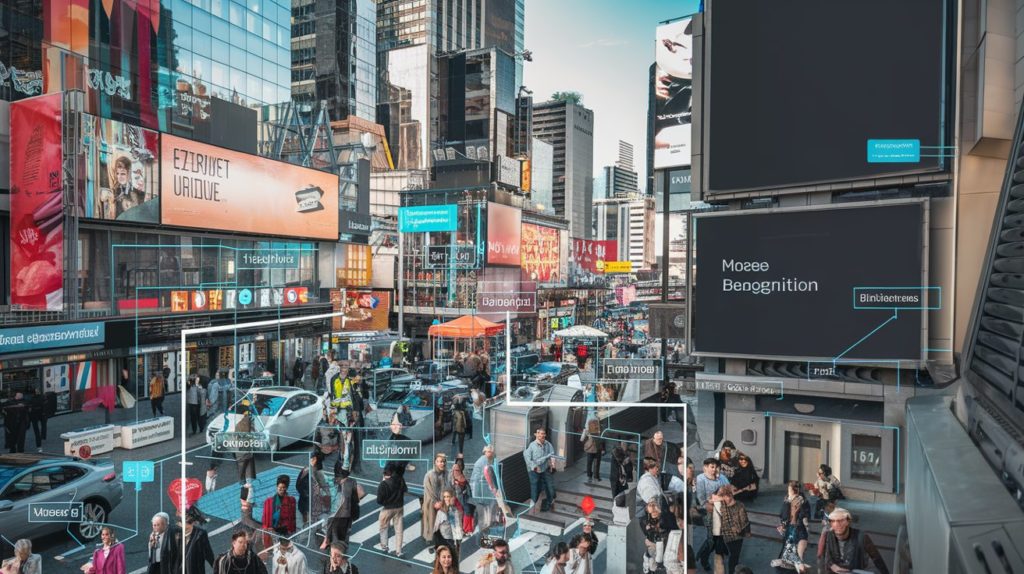
Object detection allows us to identify objects within an image or video. It differs from image classification which involves labelling the whole image. Besides the capability to automatically identify objects, object detection also includes the identification of their locations with the help of drawing bounding boxes around them. This is crucial in a number of computer vision applications like security systems, quality control, and self-driving vehicles.
Identification and verification of people is done with the help of facial recognition in a number of different contexts — from security and surveillance to image tagging on social media and personalization of products and services. The image recognition model maps the individual’s facial features and thus crafts a unique biometric signature. It is then used to identify a face in different settings.
With the help of scene classification, the recognition of the context and environment of a visual become possible. This image recognition system task is important in photo album sorting, image catalogue and listings analysis, and self-driving vehicles, among others. Through scene classification, image recognition software can provide the larger context of digital images that helps their overall understanding.
Last but not least, optical character recognition (OCR) allows the detection and extraction of text from images. Its applications are manyfold — from identification of vehicle license plates to digitizing paper documents. OCR makes seamless the conversion of text on paper into digital format that can be analyzed, searched, and archived.
Applications of Image Recognition
The use of the technology is wider than we might suspect. Some of its most common applications include online platforms, healthcare and medical imaging, security, and self-driving cars.
Online Platforms
Image recognition improves user experience, enhances security and boosts personalization for different types of online platforms.
- Dating platforms: It helps identify fake profiles through analysis of profile images for potential manipulations and ID verification. Content moderation based on image recognition filters out inappropriate content such as offensive or explicit images, promoting safety.
- Social media and content sharing: Image recognition software provides auto-tagging in photos, which is a popular perk on social media. Its use in content moderation is also crucial, as it detects and removes offensive content, contributing to the safety of online platforms. Image recognition also provides for enhanced user interactions through targeted content and personalized ads.
- E-commerce: Image recognition identifies images in online search. With its help, people can conduct image-based searches for products, which makes the shopping experience much easier. Through analysis of previous purchases, image recognition helps the creation of personalized recommendations too.
Healthcare and Medical Images
With the help of AI-powered image analysis, healthcare providers have invaluable tools for improving diagnostics and early detection of illnesses. Image recognition is particularly useful in the identification of anomalies in X-rays, MRIs, and CT scans through automated image analysis.
The image recognition systems can identify irregularities in scans such as tumors, fractures, or other signs of diseases, which makes the diagnostic process faster and less prone to errors. It also helps automate tasks and allows medical staff to focus on to the more significant features of patient care.
Security and Surveillance
Being a subset of computer vision, image recognition powers up the enhancement of security systems. Facial recognition, object detection, and monitoring for suspicious activity provide for improved overall security. Image recognition systems can identify individuals in video footage and cross-check in databases, boosting threat detection and improving response times.
Face recognition helps access control and person identification in public or secure areas. Automatic detection of unusual items and unauthorised behavior is also enabled by object detection.
Autonomous Systems

Autonomous systems like self-driving vehicles and drones rely on computer vision for the interpretation of visual information that allows them to move in space. Equipped with cameras and sensors that constantly supply new images, they can understand their surroundings and differentiate the elements on the road like vehicles, pedestrians, and traffic signs. This allows them to avoid obstacles and incidents and navigate in complex environments.
Benefits of Image Recognition
Image recognition powered by deep learning or machine learning holds immense potential for both businesses and individuals.
Its benefits are manifold, including:
- Efficiency and automation: Image recognition algorithms help decrease manual work in repetitive and time-consuming tasks in all kinds of industries. Automating processes like defect detection saves up a ton of time and effort in fields like manufacturing and engineering.
- Improved Accuracy: When it comes to tasks that require high levels of precision, as well as consistency, AI-powered image recognition can perform better than us. In areas like medical image analysis, the increased accuracy that it can offer can be of huge importance.
- Enhanced User Experiences: Automatic tagging and personalized content are perks that many of us enjoy on social media channels. In e-commerce and retail, capabilities such as visual search of products and tailored recommendations are certainly driving customer satisfaction.
- Scalability: Businesses that have to handle large-scale visual data in an effective way simply need image recognition. It allows them to keep up on accuracy and performance, while having the possibility to increase the volume of processed visual information.
Challenges in Image Recognition
Data Privacy and Ethical Concerns
Image recognition software raises a number of ethical and data privacy concerns, and they mostly revolve around facial recognition technology. While its use is welcomed when it comes to photo tagging, it can also be used for unauthorized surveillance or even criminal misuse. Monitoring people without their consent and handling sensitive personal data are issues that still haven’t found an all-round solution. Balancing between personal privacy and tech advancements is certainly a field that proves challenging — as it requires both adequate policy-making and enforcement.
Bias in AI Models
AI models are trained on datasets — and the fairness of the datasets will inevitably reflect on the fairness of these models. If the datasets are not diverse enough, this can lead to biased patterns in the image recognition model, which has proven to be the case for people of color, for example. Careful selection of diverse training data is thus key to ensure fair representation and treatment.
High Computational Requirements
Deep learning models like convolutional neural networks (CNNs) that are used in computer vision systems need a lot of computational power. This requires large-scale GPUs and special infrastructure, which can be expensive and complex to build — and difficult to access for smaller businesses.
Handling Complex Contexts
While AI-powered image recognition develops rapidly, there are some limitations to the current technology in terms of understanding complex contexts and deeper meanings in images. The biggest challenges are in grasping emotional and social contexts, as well as understanding interactions.
The Future of Image Recognition
As technological advancements in the AI field are already reshaping our concepts of what’s possible, we can expect that the coming years will bring significant innovations in the field of machine learning image recognition and computer vision as a whole.
Emerging Trends
A number of new trends in the field are developing, but there are two in particular that we believe hold significant potential.
Integration of real-time image recognition algorithms in augmented reality (AR) and virtual reality (VR) is one of them. It boosts the capabilities of AR and VR applications by enabling them to interact with and identify objects present in the real world. The uses of this integration are numerous, including retail, simulations, and gaming.
The other significant trend is the development of AI-powered multimodal systems that combine image, text, and audio. This helps the creation of applications that have a greater understanding of human context and our ways of communication.
Potential Innovations
The possible venues for innovation in computer vision are expanding constantly, but at the moment, there are three that we believe are truly intriguing.
A novel application is in smart cities. With the help of image recognition, they can be improved with smart traffic management and enhanced safety.
An especially important application of the technology is the creation of advanced medical solutions. They can become crucial tools for predictive diagnostics, early disease detection, and individually tailored healthcare plans.
Ethical AI Development
The development of machine learning image recognition should go hand in hand with upholding high ethical standards. The most important issues include fair models, privacy, and transparency. Achieving these goals entails the usage of diverse and fair datasets for model training, as well as prioritising privacy in AI development.
How AI-Driven Solutions Are Transforming Image Recognition
As a pioneer in the image recognition field, at Imagga we are exploring and developing the AI field for more than a decade. We are embedding cutting edge AI technology to provide our clients with the best tools for their business needs.
Our AI-powered technology offers powerful tools for image tagging, facial recognition, visual search, and adult content detection, and more. We strive to drive innovation while integrating an ethical approach to all our work. Let's get in touch to discuss your case.
Conclusion
Image recognition is one of the most powerful and impressive applications of AI today. It is bringing unseen innovation across industries — from e-commerce and social media to healthcare and manufacturing.
Driven by an ethical AI development approach, novel applications hold immense potential. They are able to help improve the way we work, interact with machines, and get healthcare, among many other fields — with promising potential innovations in multimodal AI systems, practical applications in healthcare and smart cities, and real-time image recognition in AR and VR.
The technology can achieve remarkable accuracy when trained on high-quality and diverse datasets.
Our cognitive process involves perceiving objects through context, experience and memory. Computer vision, on the other hand, entails image processing through mathematical matrices.
Image recognition has numerous real-time applications like face detection , security surveillance, content moderation, AR and VR, autonomous vehicles and systems, and more.
Image recognition models are trained on diverse datasets which enables image processing in different lightning, background, and angles.
The main ethical considerations include user privacy, transparency of technological development, and bias in AI models due to limited training data.
Integration of AI-powered image recognition tools is possible through cloud-based services, APIs, and custom-made models.


